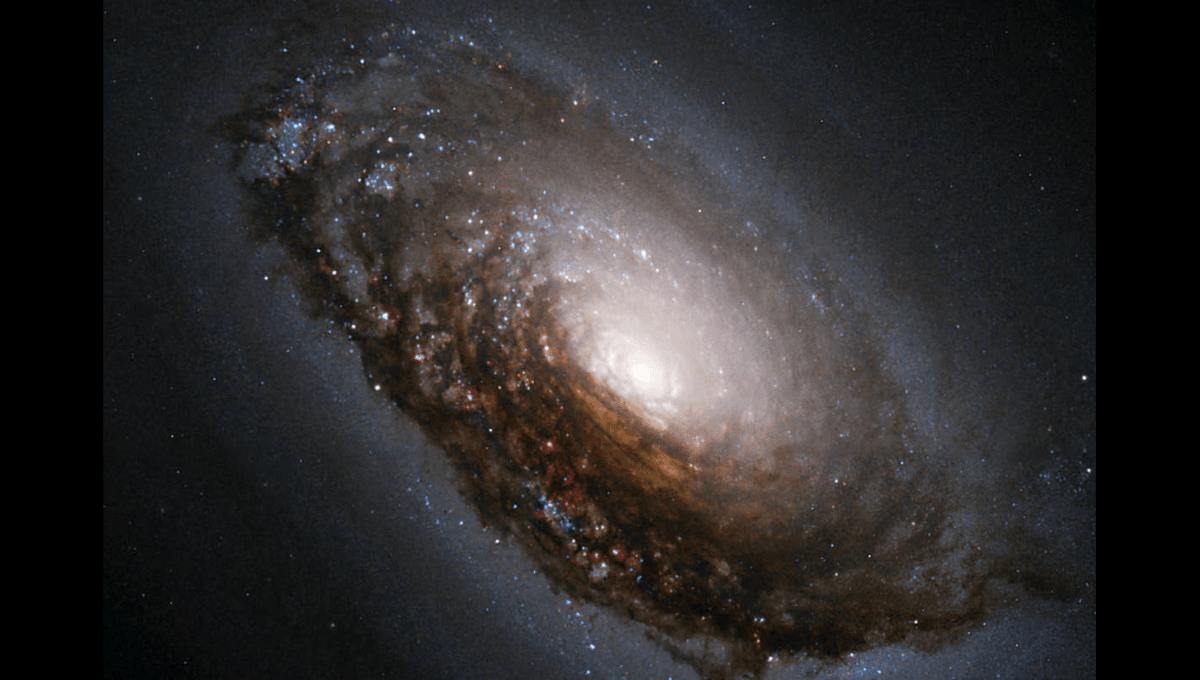
The strange appearance and counter-rotation of the nearby galaxy M64 can be explained by a recent merger with a small galaxy similar in mass to the Sun’s near neighbor the Small Magellanic Cloud (SMC). The Milky Way is expected to consume the SMC eventually so this may offer a view of our distant future.
M64 was cataloged by Charles Messier in his list of objects easily confused with comets. As telescopes improved, astronomers came to notice how dusty its nucleus looks compared to that of other nearby galaxies, made particularly visible on one half by our perspective. Stranger still, it has an outer hydrogen-rich disk that rotates around the galactic center in the opposite direction to most of its stars.
These features were initially explained as being the result of a recent merger with a small galaxy, but other telltale signs of such a merger proved elusive. Consequently, some astronomers offered alternative theories on how M64 could be so unusual. A paper to be published in The Astrophysical Journal Letters, provides evidence the original explanation was right all along, with some detail added.
According to the authors, M64 has a radial shell pointing to the southeast and northwest of the spiral galaxy, resulting from the consumption of a small galaxy. Allowing for material that has already migrated from the shell to the galaxy’s inner disk, the total mass of the consumed object is around 500 million solar masses, the same as the SMC. It also has a low concentration of metals, similar to the SMC, indicating less stellar evolution than in the larger galaxies.
Although galaxy merger is the obvious explanation for M64’s oddities, searches for counter-rotating stars turned up nothing. Even if the captured galaxy was relatively gas-rich and star poor, we would still expect to see some stars moving in the direction of the captured gas. The absence inspired the theory that the backward-spinning gas was captured from the intergalactic medium, although why this would happen around M64 and not other galaxies is unclear.
The study’s authors searched for red giant branch (RGB) stars, luminous enough to be individually visible even at the M64’s distance of 14.3 million lightyears. They found these trace out two radial plumes asymmetrically stretching from the main galaxy. The southern plume is sharp and extends 150,000 light years, while the northern one is more diffuse but reaches a distance of 330,000 light years – much further than the Milky Way’s diameter.
Despite their differing composition, the two plumes are thought to have similar masses, although the uncertainty about the northern one is much larger. “We estimate a stellar mass in the southern shell as = 1.80 ± 0.54 ×108 [solar masses],” the authors write. “We estimate a nearly equal stellar mass in the northern plume of = 1.42 ± 0.71 ×108 [solar masses]. Using the profile of inferred accreted stars in M64’s inner disk, … we estimate that another 2.13 ± 0.64×108 [solar masses] of accreted stellar mass exists in M64’s interior.”
The authors conclude the plumes represent the legacy of two passages of the former galaxy as it dissolved into M64. The southern plume comes from a more recent encounter, less than a billion years ago, which is why it remains more tightly bunched. Mergers are regular feature of galaxy building – the Milky Way has been through many – but most galaxies don’t look like M64. The specific features of the consumed galaxy, and the angle at which it encountered M64, were required to create the outcome we see.
“We suggest that its outer gas disk was accreted recently during a 52:1 merger with an SMC-mass galaxy and is now colliding with an existing inner gas disk, fueling a burst of star formation at the disk–disk interface and driving the visible dust lanes from which it earns its name,” the authors write.
The preprint is available at arXiv.
[H/T: ScienceAlert]
Source Link: Why This Galaxy Seems To Be Giving Everyone The Evil Eye